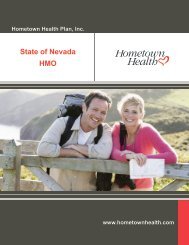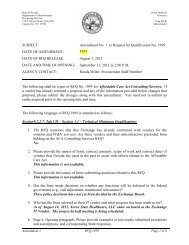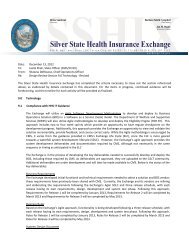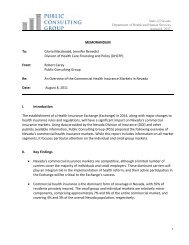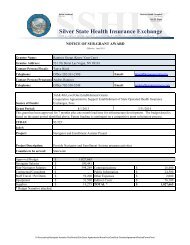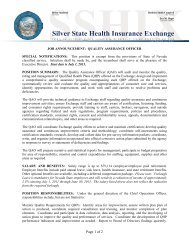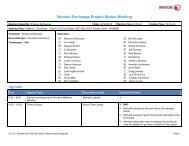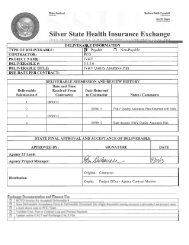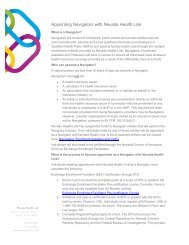Rate and Form Filing Seminar - Silver State Health Insurance ...
Rate and Form Filing Seminar - Silver State Health Insurance ...
Rate and Form Filing Seminar - Silver State Health Insurance ...
You also want an ePaper? Increase the reach of your titles
YUMPU automatically turns print PDFs into web optimized ePapers that Google loves.
Managing Existing Product Portfolios
Non-Gr<strong>and</strong>fathered Individual <strong>and</strong> Small<br />
Group Products<br />
• Must comply with new market rules upon renewal<br />
on or after 1/1/2014<br />
• These requirements are also applicable to closed<br />
block products<br />
• A 60 day renewal with altered terms notice will be<br />
required<br />
• Closed blocks will not be allowed beginning<br />
1/1/2014
Mapping Non-Gr<strong>and</strong>fathered Products<br />
• Mapping strategies must be submitted by<br />
3/1/2013 as part of a carrier’s individual <strong>and</strong><br />
small group annual operations reports<br />
• Reasonable mapping strategies may include<br />
- Moving to closest actuarial value plan<br />
- Minimizing premium disruption<br />
- Maintaining current provider network
Products Open on 3/23/2010<br />
• Nevada will consider a product that contains both<br />
gr<strong>and</strong>fathered <strong>and</strong> non-gr<strong>and</strong>fathered policies to be<br />
two distinct products<br />
• Discontinuation of the entire product for<br />
obsolescence is allowed with a 180 day notice to<br />
policyholders<br />
• Alternatively, the product will be considered a<br />
closed block gr<strong>and</strong>fathered product if no nongr<strong>and</strong>fathered<br />
policies remain on 1/1/2015
Single Risk Pool<br />
The premium rate for any non-gr<strong>and</strong>fathered<br />
individual or small group plan can vary from the<br />
market wide index rate only for the following factors:<br />
– The actuarial value <strong>and</strong> cost-sharing design of the plan<br />
– The plan’s provider network <strong>and</strong> delivery system<br />
characteristics<br />
– Plan utilization management practices<br />
– Plan benefits in addition to the essential health benefits
Nevada Rating B<strong>and</strong>s<br />
Individual Market Now<br />
50% Between Blocks
Nevada Rating B<strong>and</strong>s<br />
Individual Market 1/1/2014<br />
Single Risk Pool<br />
Non-<br />
Gr<strong>and</strong>fathered<br />
Plans<br />
50% Between Blocks
Nevada Rating B<strong>and</strong>s<br />
Small Group Market Now<br />
20% Between Classes
Nevada Rating B<strong>and</strong>s<br />
Small Group Market 1/1/2014<br />
Single Risk Pool<br />
Non-<br />
Gr<strong>and</strong>fathered<br />
Plans<br />
20% Between Classes
<strong>Filing</strong> Products in 2013<br />
• The filing process for gr<strong>and</strong>fathered <strong>and</strong> large group<br />
products mostly remains unchanged<br />
• Carriers will need to obtain plan ID’s from HHS through<br />
HIOS for all new non-gr<strong>and</strong>fathered plans in <strong>and</strong> out of the<br />
Exchange<br />
• Carriers will need to complete the rate filing template in<br />
HIOS for all non-gr<strong>and</strong>fathered individual <strong>and</strong> small group<br />
product rate filings beginning 4/1/2013
Non-Gr<strong>and</strong>fathered Product <strong>Filing</strong>s<br />
• <strong>Form</strong> filings can be submitted beginning 2/1/2013<br />
• Individual <strong>and</strong> small group product form filings must include<br />
both input <strong>and</strong> output from the Actuarial Value Calculator<br />
• Adequate data <strong>and</strong> documentation to support actuarial<br />
equivalent benefit substitutions must also be provided<br />
• Individual <strong>and</strong> small group rate or form/rate filings can be<br />
submitted beginning 4/1/2013
Non-Gr<strong>and</strong>fathered Product <strong>Filing</strong>s<br />
• No more than one product per filing will be allowed<br />
• A product will consist of various plans<br />
• Plans within a product should only vary by cost sharing<br />
structure<br />
• Benefit <strong>and</strong> network variability within a product will not<br />
be allowed
<strong>Rate</strong> Review
<strong>State</strong> Decisions<br />
Within 30 days of publication of the final rule,<br />
Nevada will need to decide on:<br />
• Age curve<br />
• Age rating, if less than 3:1<br />
• Geographic rating areas<br />
• Merger of individual <strong>and</strong> small group risk pools<br />
• Whether composite rates are required in small group<br />
market<br />
• Tobacco rating, if less than 1.5 to 1
Rating areas<br />
• Apply uniformly to all non-gr<strong>and</strong>fathered plans in<br />
individual <strong>and</strong> small group market<br />
• Presumed adequate (default) if:<br />
– There is only one rating area within a state, or<br />
– Seven or fewer rating areas based on:<br />
• Counties<br />
• 3-digit area codes<br />
• Metropolitan Statistical Areas (MSAs) / non-MSAs<br />
• A state may define the rating areas based on<br />
different criteria, subject to approval by CMS<br />
• Considerations in selecting rating areas<br />
• Current rating areas used by carriers<br />
• Minimize disruption
Geographic Rating<br />
Areas By Carrier –<br />
Individual Market<br />
Based on 2012 study of the<br />
Nevada <strong>Health</strong> <strong>Insurance</strong><br />
Market by Gorman Actuarial.<br />
• One of the carriers<br />
surveyed did not vary<br />
rates by geographic area.<br />
• Some carriers used<br />
slightly different rating<br />
areas for small group.<br />
• Carriers used a maximum<br />
of 4 rating areas.<br />
• General consistency in<br />
rating areas among<br />
carriers.
Nevada Rating<br />
Areas for 2014<br />
Four Rating Areas:<br />
1. Clark county plus Pahrump<br />
2. Washoe county<br />
3. Carson City, Lyon <strong>and</strong> Douglas<br />
<strong>and</strong> Storey counties<br />
4. All other counties
Geographic Rating<br />
Factors<br />
• Federal regulations are<br />
silent on responsibility<br />
for setting rating factors<br />
• <strong>State</strong>s can set the<br />
rating factors<br />
2010 Geographic Rating Factors - Individual Market<br />
Minimum Maximum Average<br />
Las Vegas Area -1% 14% 2%<br />
Reno Area -10% 19% -4%<br />
Other 20% 22% 22%<br />
2010 Geographic Rating Factors –Small Group Market<br />
Minimum Maximum Average<br />
Las Vegas Area -7% 3% -2%<br />
Reno Area -7% 20% 6%<br />
Other 22% 50% 23%
Geographic Rating Factors<br />
• Carriers may continue to determine rating<br />
factors in Nevada<br />
– Methodology must be actuarially sound<br />
– Cannot be based on claims experience<br />
• Because it will reflect prohibited factors such as<br />
health status<br />
– Should reflect provider contracts<br />
– Basis must be fully documented in actuarial<br />
memo
Changes to Effective <strong>Rate</strong> Review<br />
St<strong>and</strong>ards<br />
• Nevada must now review:<br />
– Reasonableness of assumptions used to estimate the rate<br />
impact of the federal reinsurance <strong>and</strong> risk adjustment<br />
programs<br />
– Carriers’ data related to the implementation of the<br />
• Market-wide single risk pool<br />
• Essential health benefits<br />
• Actuarial values<br />
• Other market reforms<br />
– Impact of cost-sharing changes<br />
– Impact of geographic factors <strong>and</strong> variations<br />
– Impact of changes within a single risk pool, on all products<br />
or plans within the risk pool
Actuarial Memor<strong>and</strong>um - <strong>Form</strong>s<br />
• <strong>Form</strong>s filed separately from rates will be<br />
automatically disapproved if an actuarial<br />
memor<strong>and</strong>um is not included.<br />
• The DOI will be reviewing forms for:<br />
– Discriminatory benefit design<br />
– Substantially similar benefits offered inside<br />
<strong>and</strong> outside the Exchange
Actuarial Memor<strong>and</strong>um - <strong>Form</strong>s<br />
• The actuarial memor<strong>and</strong>um accompanying<br />
forms must include support for:<br />
– Calculation of actuarial value (AV). At a minimum,<br />
include:<br />
• Assumptions <strong>and</strong> methodology used to project the<br />
expected average paid <strong>and</strong> allowed claims<br />
• Include documentation from AV calculator – inputs <strong>and</strong><br />
outputs<br />
• If AV calculator is not used, provide detailed description<br />
of methodology <strong>and</strong> assumptions, including the<br />
justification of why they are appropriate
Actuarial Memor<strong>and</strong>um - <strong>Form</strong>s<br />
– Actuarially equivalent substitutions for dollar<br />
limits. Include:<br />
• Detailed descriptions of assumptions <strong>and</strong><br />
methodology.<br />
• Justification of appropriateness of data,<br />
assumptions <strong>and</strong> methodology used. The<br />
substitutions must be appropriate for the coverage<br />
– Other actuarially determined items
Actuarial Memor<strong>and</strong>um - <strong>Rate</strong>s<br />
Carriers will need to provide detailed descriptions of assumptions <strong>and</strong><br />
methods used to determine items affecting the premium levels for new<br />
<strong>and</strong> existing plans. This will include a detailed description of the<br />
underlying data <strong>and</strong> a discussion of the appropriateness of the data<br />
used to determine the assumptions for:<br />
• Index rates<br />
• Experience Period Premium <strong>and</strong> Claims<br />
• Projection Factors<br />
– Trend<br />
– Morbidity of uninsured<br />
• Include modeling methodology <strong>and</strong> assumptions<br />
• At a minimum, be prepared to demo the model to DOI staff<br />
– New benefits (EHB)<br />
– Other<br />
• Credibility
Actuarial Memor<strong>and</strong>um, Cont’d<br />
• Impact of premium stabilization programs<br />
– Estimate risk transfer payments <strong>and</strong> impact of transitional<br />
reinsurance program (individual market only)<br />
– Detailed description of the modeling methodology<br />
– At a minimum, be prepared to demo the model to DOI staff<br />
• Non-Benefit Expenses<br />
• Allowed Rating Factors<br />
– Age<br />
– Geography<br />
– Tobacco use<br />
– Family composition
Actuarial Memor<strong>and</strong>um, Cont’d<br />
• Ratio of expected paid claims to allowed claims (Actuarial<br />
Value)<br />
– Assumptions <strong>and</strong> methodology used to project the expected<br />
average paid <strong>and</strong> allowed claims<br />
– Include documentation from AV calculator – inputs <strong>and</strong> outputs<br />
– If AV calculator is not used, provide detailed description of<br />
methodology <strong>and</strong> assumptions, including the justification of why<br />
they are appropriate<br />
• Actuarially equivalent substitutions for dollar limits. Include:<br />
– Detailed descriptions of assumptions <strong>and</strong> methodology.<br />
– Justification of appropriateness of data, assumptions <strong>and</strong><br />
methodology used. The substitutions must be appropriate for the<br />
coverage
Actuarial Memor<strong>and</strong>um, Cont’d<br />
• Company Financial Position<br />
– Pure loss ratio at plan, product,<br />
market <strong>and</strong> company levels<br />
• Incurred claims<br />
• Earned premiums<br />
– Expected MLR<br />
– Admitted assets<br />
– Capital <strong>and</strong> surplus<br />
– Net earned premiums<br />
– Net underwriting gain / (loss)<br />
– Investment income<br />
– Net investment realized gain /<br />
(loss)<br />
– Net income (loss)<br />
• Actuarial Certification<br />
– Certify compliance with:<br />
• Applicable statutes <strong>and</strong><br />
regulations of the <strong>State</strong><br />
of Nevada<br />
• Applicable federal<br />
statues <strong>and</strong> regulations;<br />
• Applicable Actuarial<br />
St<strong>and</strong>ards of Practice<br />
(ASOPs)
2014 ACA Fees in 2013 Premiums<br />
ACA imposes fees on issuers<br />
• Annual fee on health insurers (ACA sec. 9010)<br />
– Based on previous year’s premium<br />
• Transitional Reinsurance Program Assessments<br />
– $5.25 PMPM in 2014<br />
• Comparative effectiveness research assessment<br />
– $1PMPM in 2013, $2 PMPM in 2014 to 2009<br />
• Timing of inclusion of fees in premiums for noncalendar<br />
year plans
2014 ACA Fees in 2013 Premiums<br />
• Considered several approaches<br />
• Biggest concern – uncertainty of lapse<br />
experience due to the impact of market reforms<br />
starting January 1, 2014<br />
– Can be alleviated by:<br />
• Refunds to members terminating before the end of the year<br />
• Explicit termination assumption
2014 ACA Fees in 2013 Premiums<br />
• Decision: DOI will approve rates for the entire<br />
plan year without fees<br />
– Allows for itemizing of fees<br />
– Allows adequate time to price <strong>and</strong> implement fees<br />
– Members who terminate coverage before 2014 will<br />
not have to pay these fees<br />
• Carriers may file for rate increase to reflect fees<br />
only effective January 1, 2014<br />
– Will consider implementing an expedited process to<br />
accommodate efficient review.
Essential <strong>Health</strong> Benefits
Essential <strong>Health</strong> Benefits<br />
• Also known as “EHBs”<br />
• Establishes a minimum level of coverage<br />
• Chosen by Nevada for Nevadans<br />
• Applies to all non-gr<strong>and</strong>fathered individual <strong>and</strong><br />
small group insurance plans<br />
• Applies to plans sold on <strong>and</strong> off the Exchange
EHB Requirements<br />
• No annual dollar limits<br />
• No lifetime dollar limits<br />
• Service/visit limits ARE allowed<br />
• Adult vision <strong>and</strong> dental are NOT EHBs
EHB Restrictions<br />
• Since dollar limits are prohibited, each carrier<br />
must either provide the coverage without a limit<br />
or establish an actuarial equivalent substitution<br />
• Nevada’s EHB package will apply for years 2014<br />
<strong>and</strong> 2015
EHB Package Chosen<br />
<strong>Health</strong> Plan of Nevada<br />
Point-of-Service C-XV<br />
<strong>Form</strong> #: HPN POS C-XV<br />
This was the largest small employer<br />
plan in the state.
Missing Services<br />
• Habilitative services must be in parity with<br />
rehabilitative services<br />
• Pediatric Dental supplemented by the Medicaid<br />
CHIP<br />
• Pediatric Vision supplemented by the FEDVIP
Dollar Limits No Longer Allowed<br />
Applied Behavioral Analysis:<br />
$36,000 annual limit<br />
Inherited Metabolic Disease:<br />
$2,500 annual limit for special foods<br />
Bariatric Surgery:<br />
$5,000 lifetime limit<br />
Manual Manipulation of the Spine:<br />
$1,000 annual limit
Dollar Limits No Longer Allowed<br />
Durable Medical Equipment:<br />
$4,000 lifetime limit<br />
Prosthetic <strong>and</strong> Orthotic Devices:<br />
$10,000 lifetime limit<br />
TMJ:<br />
$2,500 annual limit; $4,000 lifetime limit<br />
Hearing Aids:<br />
$5,000 annual limit
Organ <strong>and</strong> Tissue Transplant:<br />
Procurement<br />
$15,000 per transplant / per benefit period<br />
Travel Lodging <strong>and</strong> Meals<br />
$10,000 per transplant / per benefit period<br />
Daily Lodging <strong>and</strong> Meals<br />
$200 per day
Physical Therapy, Speech Therapy <strong>and</strong><br />
Occupational Therapy:<br />
60 visits per year combined<br />
Private Duty Nursing:<br />
30 visits per year<br />
Skilled Nursing Facility:<br />
100 days per year<br />
Home <strong>Health</strong> Care Services:<br />
30 visits per year
Hospice Services:<br />
Benefits for expenses arising from hospice care<br />
Hospice Bereavement Services:<br />
5 visits per year; treatment must be completed within 6 months<br />
of the date of death<br />
Infertility Office Evaluation Visits:<br />
Covered as a physician visit<br />
Infertility Treatments:<br />
6 cycles per person per lifetime
The formulary benchmark is the greater of the<br />
number of drugs in the benchmark plan formulary<br />
or one in every distinct pharmacopeia category <strong>and</strong><br />
class.<br />
• Br<strong>and</strong> name drugs <strong>and</strong> generic drugs are not<br />
chemically distinct<br />
• Dosage size is not chemically distinct<br />
• <strong>Form</strong>ulary quantity is locked in until 2016
Plan Certification
Qualified <strong>Health</strong> Plans<br />
• Carriers will be able to offer up to five plans per<br />
metal tier per service area<br />
• Individual market plan offerings will be in place for<br />
one year<br />
• Changes to individual market QHPs can only be<br />
made annually, prior to the open enrollment period<br />
• <strong>Rate</strong>s must be set for an entire benefit year, or plan<br />
year for products in the SHOP Exchange
Certified Carriers<br />
• Carriers must offer at least one silver <strong>and</strong> one gold<br />
plan<br />
• Carriers must offer 73%, 87% <strong>and</strong> 94% variations<br />
of each st<strong>and</strong>ard silver plan for individuals with<br />
household incomes below 250% of the FPL<br />
• Carriers must offer no-cost sharing variations for<br />
Native Americans with household incomes below<br />
300% at each metallic level of coverage
Certified Carriers<br />
• Carriers in the individual market may offer one<br />
catastrophic plan. Catastrophic plans may only be<br />
sold to people under age 30 at the start of the plan<br />
year, people for whom coverage is considered<br />
“unaffordable” under 5000A(e)(1) of the Internal<br />
Revenue Code (IRC), <strong>and</strong> people with a “hardship”<br />
under 5000A(e)(5) of the IRC
Accreditation<br />
• Carriers must either have a current accreditation by<br />
NCQA, URAC or another accreditation entity<br />
recognized by HHS or demonstrate, during QHP<br />
certification, evidence of a scheduled accreditation<br />
survey that will be completed within 24 months of<br />
the date of application for certification<br />
• A carrier that does not receive accreditation within<br />
24 months of the date of application for certification<br />
will lose their QHP status following the completion<br />
of the plan year in which the deadline occurred
Submitting Qualified <strong>Health</strong> Plans<br />
• QHPs must be submitted through SERFF within<br />
“Binders”<br />
• Binders will be available in SERFF on 3/28/13<br />
• Submission of a binder will initiate the<br />
certification process for a carrier<br />
• A separate certification application will not be<br />
required
QHP Data Collection<br />
• The Division of <strong>Insurance</strong> will collect QHP data using<br />
SERFF binders<br />
• Carriers will need to provide plan <strong>and</strong> company<br />
information using data templates within binders<br />
• Nevada will not deviate from the st<strong>and</strong>ard templates<br />
used by HHS for the FFE<br />
• Additional carrier <strong>and</strong> product information needed by<br />
the Exchange will be collected within other binder fields<br />
outside the st<strong>and</strong>ard data templates
St<strong>and</strong>ard Data Templates<br />
• There are currently eight draft templates:<br />
– Administrative Data Template<br />
– Plan Benefits Template<br />
– <strong>Rate</strong>s Template<br />
– Rating Rules Template<br />
– Service Area Template<br />
– Network Template<br />
– Prescription Drug Template<br />
– Essential Community Providers Template
Certification Timeline<br />
• Thursday, March 28 th : Carriers can submit<br />
“Binders” via SERFF<br />
• Friday, June 7 th : Deadline for submission of initial<br />
“Binder”<br />
• Friday, July 5 th : Final day to submit a “Binder”<br />
• Thursday, August 1 st : All “Binders” must be<br />
approved in order for QHPs to be available for<br />
OPEN enrollment



